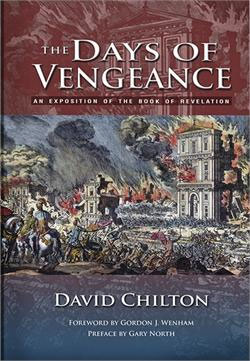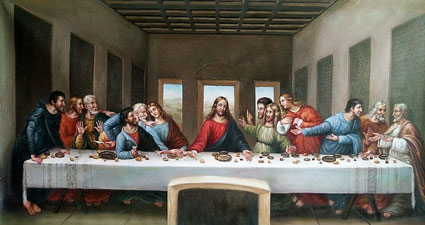Apr
10
2009
A Conspiracy of Nations
Amalek is the archenemy of the saints. This first Amalek most likely descended from Japheth. Numbers 24:20 paints him as the original great “Sea beast”, and a counterfeit Alpha and Omega.
“Amalek was the first of the nations, but his end shall be destruction.”
Esau moved to Mount Seir and merged with the Horites to become ahybrid part-Canaanite people known as Edomites. One of Esau’s grandsons was named Amalek (Genesis 36:16), which shows a conscious or subconscious alliance between Gentile hatred and false brother hatred of God’s chosen son—a “Land beast”. This has an enormous impact on interpreting the later history of the Bible.1
Continue reading
Comments Off | tags: Amalek, Bible history, Deborah, Edomites, Esau, Jabin, Jericho, Judges, Resurrection, Sisera, Solomon, Typology | posted in Against Hyperpreterism, Biblical Theology, The Last Days
Apr
10
2009
Did God replace Judaism or merely put it on hold?
Being a Jew was never a matter of bloodline, but of Covenant. Think of Abraham’s servants circumcised in Genesis 17, the Egyptians at the Exodus, Caleb the Kenizzite, Rahab, Ruth, Uriah, etc. It seems the Old Testament keeps throwing us examples of people “grafted in.” The only actual bloodline of any importance is the one we are given, the family tree from Abraham to Christ.
Israel’s captivity and Restoration gave us a perfect picture of the New Covenant events. The Temple and walls of the old Israel were ‘de-created’ and God Himself (the ark) died in Babylon for the sake of a new Jerusalem with impregnable walls.
Christ was the human ark. Judaism, intermarried with Roman political power, became Babylon.
My point is, the captivity was a death-and-resurrection of first century Israel (the resurrection as predicted in Ezekiel 37) in type. The first century was the antitype. Thus, whatever remains of Judaism today is like exhumed idols from the eras of Jeroboam, Ahab*, Omri and Manasseh.
It is not about blood. It never was. It is about Covenant, and there is only one of those. Despite its various death-and-resurrection renewals, there has only ever really been one covenant. There is no replacement of God’s people, only transfiguration from glory to glory.
*Remember it was Jezebel’s daughter Athaliah that almost DID destroy this single bloodline that mattered. Jehoash was the single son who escaped, an echo of Moses and a type of Christ.
6 comments | tags: Abraham, Ahab, Ark of the Covenant, Athaliah, Babylon, Covenant curse, Dispensationalism, Genesis, Jezebel, Joash, Replacement Theology, Resurrection, Ruth | posted in Biblical Theology
Apr
10
2009
Land.

I read David Chilton’s The Days of Vengeance in 1989, and it sure surprised me to learn that the word ‘earth’ in the Bible also means ‘land.’ This simple fact alters the scope of John’s Revelation entirely. It is about God’s ending of the Covenant He restored after the Babylonian captivity, and so first century Judah is the main subject. It was a repeat of events in Jeremiah’s day, so let’s backtrack a little…
Continue reading
15 comments | tags: AD70, Bible history, Compromise, David Chilton, Dispensationalism, Exile, Ezekiel, Noah, Resurrection, Temple | posted in Against Hyperpreterism, Biblical Theology, The Last Days, The Restoration Era
Apr
10
2009

The content of this post has been revised and included in Bible Matrix II: The Covenant Key.
Comments Off | tags: Martyrdom, Moses, Priesthood, Resurrection | posted in Biblical Theology, The Last Days, Totus Christus
Apr
10
2009
What is the condition of man apart from Christ, and what salvation is offered to us in that condition? The Word of salvation does not come to sinners who are ailing. It comes to sinners who are dead. It does not come to those who have anything to contribute to the process of resurrection. When Jesus raised Lazarus from the dead, He was not pulling while Lazarus pushed. Before the word of life comes to us, before the breath of God is breathed into us, our condition is hopeless.
We are in the grip of carnal hatred. Without Christ, what does the mind of man do? Where does it gravitate? “Because the carnal mind is enmity against God: for it is not subject to the law of God, neither indeed can be” (8:7). Described another way, this condition of hatred is a form of death, and it is a death that reigns. Apart from Christ, sinners are dead — not sick. “And so death passed upon all men, for that all have sinned” (Rom. 5:12). Again, the image here should be that of Lazarus in the tomb. How much did he contribute to his resurrection?
Doug Wilson www.dougwils.com
Comments Off | tags: Doug Wilson, Resurrection | posted in Biblical Theology, Quotes
Apr
8
2009
A sample of the new ESV Study Bible was recently made available.
I liked this observation in the notes:
“Jonah’s rescue from death provides an analogy for the resurrection of Christ… The repentance of the Ninevites anticipates the wide-scale repentance of Gentiles in the messianic era.”
But not this one: “Humor, as Jonah’s behavior is not only ignominious but also ridiculous.”
When the prophets (like Elijah, Elisha and Jonah) were sent to Gentiles, it was to provoke Israel to jealousy because they would not listen to these prophets. Jonah understood his ministry meant condemnation would come upon his own people:
James B. Jordan said,
“I don’t think Jonah was some loyal nationalistic prophet. Jonah was in there every day complaining, criticising, prophesying, and denouncing the kingdom of northern Israel. It won’t do to say that Jonah didn’t want to take the Gospel to another nation. No, Jonah has something more profound in mind. Jonah was thinking about Deuteronomy 32:21. He didn’t want to take the Gospel to the Gentiles, because to do so was to bring about a curse on the Israelites. ”1
Paul was a more faithful Jonah, understanding this curse but obeying it nonetheless (Romans 9:3; Acts 28:28)
The study Bible looks good though.
1 Lectures on Jonah, available from www.wordmp3.com
[Originally posted 21 August 08]
Comments Off | tags: ESV, James Jordan, Jonah, Paul, Resurrection | posted in Biblical Theology
Apr
8
2009
High Priest in the Unholy Place
The Lampstand, Table and Incense Altar are Word, Sacrament and Government. Christ was tempted with unholy Word (bread), unholy sacrament (disobedience 1) and unholy government (a counterfeit kingdom). Couple this with the facts that He was in the wilderness for 40 days, and that Eve was tempted in the same way, and you have a definitive triune breakdown of the golden calf. It was a false Tabernacle, a metal beast instead of a metal man.
As Greater Eve, the first century church was tempted in exactly the same way, but by this point the golden calf was actually speaking. Herod’s temple was the image of the beast, the Tabernacle of the Abyss. We see its antidote in Revelation 1: a glorified metal man, come to judge a corrupted Eve (the harlot) and the beast she believed in.
__________________
1 In this case it is a false death and resurrection. TAOTA
Comments Off | tags: Altar of the Abyss, Golden calf, Lampstand, Resurrection, Revelation, Satan | posted in Biblical Theology, The Last Days



























